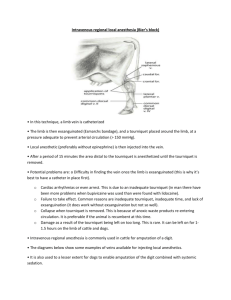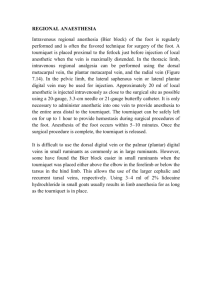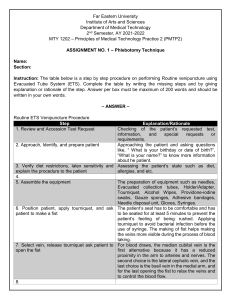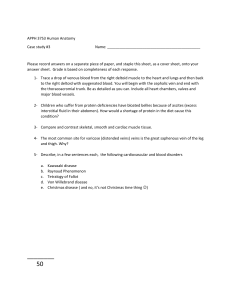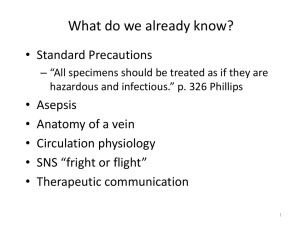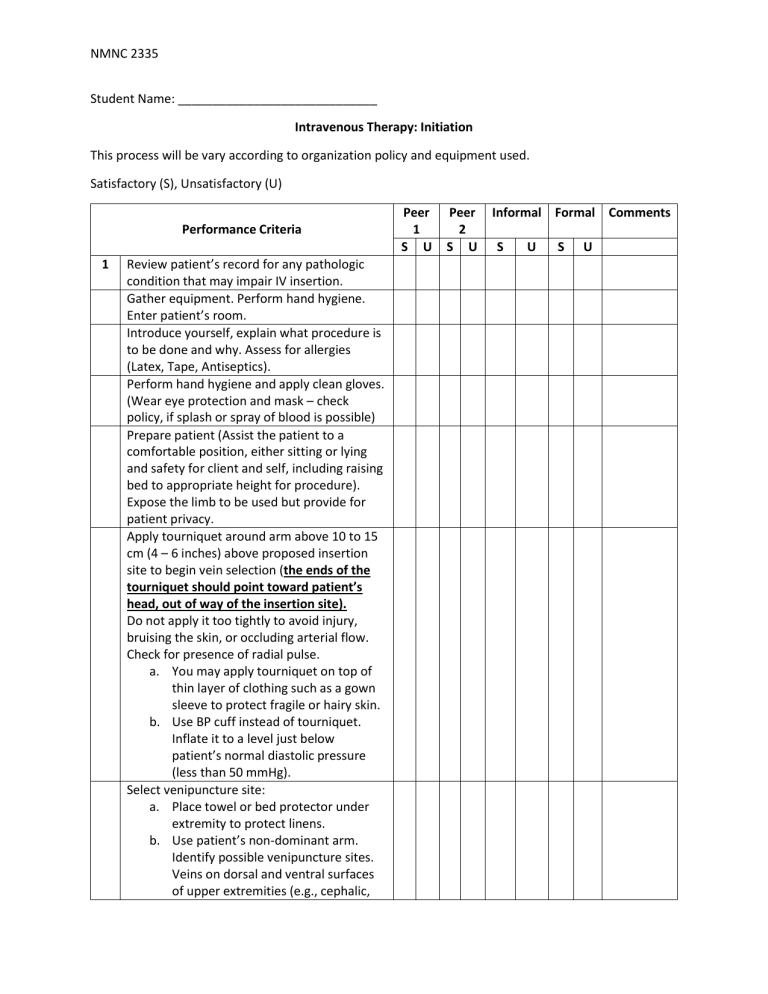
NMNC 2335 Student Name: _____________________________ Intravenous Therapy: Initiation This process will be vary according to organization policy and equipment used. Satisfactory (S), Unsatisfactory (U) Performance Criteria 1 Review patient’s record for any pathologic condition that may impair IV insertion. Gather equipment. Perform hand hygiene. Enter patient’s room. Introduce yourself, explain what procedure is to be done and why. Assess for allergies (Latex, Tape, Antiseptics). Perform hand hygiene and apply clean gloves. (Wear eye protection and mask – check policy, if splash or spray of blood is possible) Prepare patient (Assist the patient to a comfortable position, either sitting or lying and safety for client and self, including raising bed to appropriate height for procedure). Expose the limb to be used but provide for patient privacy. Apply tourniquet around arm above 10 to 15 cm (4 – 6 inches) above proposed insertion site to begin vein selection (the ends of the tourniquet should point toward patient’s head, out of way of the insertion site). Do not apply it too tightly to avoid injury, bruising the skin, or occluding arterial flow. Check for presence of radial pulse. a. You may apply tourniquet on top of thin layer of clothing such as a gown sleeve to protect fragile or hairy skin. b. Use BP cuff instead of tourniquet. Inflate it to a level just below patient’s normal diastolic pressure (less than 50 mmHg). Select venipuncture site: a. Place towel or bed protector under extremity to protect linens. b. Use patient’s non-dominant arm. Identify possible venipuncture sites. Veins on dorsal and ventral surfaces of upper extremities (e.g., cephalic, Peer 1 S U Peer 2 S U Informal Formal Comments S U S U NMNC 2335 basilica, and median veins) are preferred in adults. Check agency protocol about shaving if site is very hairy. c. Use most distal site in non-dominant area if possible. Select a well dilated vein (Sometimes you need to remove gloves to palpate vein and be sure to re-glove prior to insertion). Methods to foster venous distention include: a. Place extremity in dependent position. b. Apply warmth to extremity for several minutes. With your index finger, palpate vein by pressing downward. Note resilient, soft, bouncy feeling while releasing pressure. Avoid vein selection in: - Area with tenderness, pain, infection, or wound. - Extremity affected by previous stroke (CVA, paralysis, mastectomy, or dialysis graft). - Site distal to previous venipuncture site, sclerosed or hardened veins, infiltrate site or phlebotic vessels, bruised areas, or areas of venous valves. - Fragile dorsal veins in older adult patients and vessel in an extremity with compromised circulation. Choose a site that does not interfere with patient’s ADLs, use of mobility aids such as a cane, or planned procedures. Clip arm air with scissors if necessary (explain to patient). Release tourniquet temporarily and carefully. Apply clean gloves if not done. Prepare IV extension tubing - Prime the tubing with NS 0.9% - Ready for dual luerlock cap (loosen the luerlock cap) so that you can remove the dual luerlock cap easier to connect the IV. Use antiseptic swab or applicator (Chlorhexidine 2% is preferred) to clean insertion site. Allow to dry completely. NMNC 2335 Reapply tourniquet or BP cuff above 10 – 12 cm (4- 6 inches) above anticipated insertion site. Evaluator ____________________________________________________________________________ Peer 1 ________________________________ Peer 2________________________________________ Student ____________________________________Date_____________________________________ Revised 01/2020
